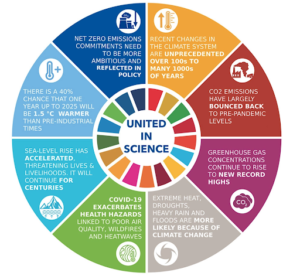In news– United in Science report published by the World Meteorological Organization (WMO) revealed that the CO2 emissions bounced back to pre-pandemic levels.
About the report-
- The report was jointly sponsored by the WMO/Intergovernmental Oceanographic Commission (IOC) of UNESCO/International Science Council (ISC) and World Climate Research Programme (WCRP).
The report provides details on:
- Greenhouse Gas Concentrations in the Atmosphere (WMO)
- Global greenhouse gas emissions and budgets (Global Carbon Project)
- Emissions Gap (UN Environment Programme)
- Global Climate in 2017-2021 and 2021-2025 (WMO, UK Met Office)
- Highlights of the Intergovernmental Panel on Climate Change Sixth Assessment Report – the Physical Science basis
- Sea level rise and coastal impacts (World Climate Research Programme)
- Heatwaves, wildfires and air pollution (World Health Organization/WMO)
Key findings-
- Human-induced climate change is already increasing the frequency and intensity of many weather and climate extremes in every region across the globe.
- COVID-19 infections and climate hazards such as heatwaves, wildfires and poor air quality combine to threaten human health worldwide, putting vulnerable populations at particular risk.
- Global mean sea levels rose 20 cm from 1900 to 2018 and at an accelerated rate of 3.7+0.5 mm/yr from 2006 to 2018.
- Even if emissions are reduced to limit warming to well below 2 °C, global mean sea level would likely rise 0.3–0.6 m by 2100 and could rise by 0.3–3.1 m by 2300 (relative to 1995-2014).
- Annual global mean near-surface temperature is likely to be at least 1 °C warmer than pre-industrial levels (defined as the 1850–1900 average) in each of the coming five years and is very likely to be within the range 0.9 °C to 1.8 °C.
- Over 2021–2025, high latitude regions and the Sahel are likely to be wetter than the recent past.
- The COVID-19 crisis offers only a short-term reduction in global emissions and will not significantly reduce emissions by 2030 unless countries pursue an economic recovery that incorporates strong decarbonization.
- The increasing number of countries committing to net-zero emission goals is encouraging, with about 63% of global emissions now covered by such goals.

Source: Hindustan Times














